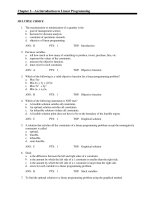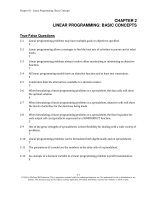Introduction to management science 10e by bernard taylor chapter 07
Bạn đang xem bản rút gọn của tài liệu. Xem và tải ngay bản đầy đủ của tài liệu tại đây (3.42 MB, 49 trang )
Network Flow
Models
Chapter 7
Copyright © 2010 Pearson Education, Inc. Publishing as
Prentice Hall
7-1
Chapter Topics
■ The Shortest Route Problem
■ The Minimal Spanning Tree Problem
■ The Maximal Flow Problem
Copyright © 2010 Pearson Education, Inc. Publishing as
Prentice Hall
7-2
Network Components
■ A network is an arrangement of paths (branches)
connected at various points (nodes) through which
one or more items move from one point to another.
■ The network is drawn as a diagram providing a picture
of the system thus enabling visual representation and
enhanced understanding.
■ A large number of real-life systems can be modeled as
networks which are relatively easy to conceive and
construct.
Copyright © 2010 Pearson Education, Inc. Publishing as
Prentice Hall
7-3
Network Components (1 of 2)
■ Network diagrams consist of nodes and branches.
■ Nodes (circles), represent junction points, or
locations.
■ Branches (lines), connect nodes and represent
flow.
Copyright © 2010 Pearson Education, Inc. Publishing as
Prentice Hall
7-4
Network Components (2 of 2)
■ Four nodes, four branches in figure.
■ “Atlanta”, node 1, termed origin, any of others
destination.
■ Branches identified by beginning and ending node
numbers.
■ Value assigned to each branch (distance, time, cost,
etc.).
Figure 7.1 Network of
Copyright © 2010
Pearson Education,
Inc. Publishing as
Railroad
Routes
Prentice Hall
7-5
The Shortest Route Problem
Definition and Example Problem
Problem:
Data
(1Determine
of 2) the shortest routes from the
origin to all destinations.
Copyright © 2010 Pearson Education, Inc. Publishing as
Prentice Hall
Figure
7.2
7-6
The Shortest Route Problem
Definition and Example Problem
Data (2 of 2)
Figure 7.3 Network
Copyright © 2010 PearsonRepresentation
Education, Inc. Publishing as
Prentice Hall
7-7
The Shortest Route Problem
Solution Approach (1 of 8)
Determine the initial shortest route from the origin
(node 1) to the closest node (3).
Figure 7.4 Network with Node 1 in the
Permanent
Set
Copyright © 2010 Pearson Education, Inc.
Publishing as
Prentice Hall
7-8
The Shortest Route Problem
Solution Approach (2 of 8)
Determine all nodes directly connected to the
permanent set.
Figure 7.5 Network with Nodes 1 and 3 in the
Permanent
SetInc. Publishing as
Copyright
© 2010 Pearson Education,
Prentice Hall
7-9
The Shortest Route Problem
Solution Approach (3 of 8)
Redefine the permanent set.
Figure 7.6 Network with Nodes 1, 2, and 3 in
Copyright © 2010 Pearson Education, Inc. Publishing as
Prentice
the Hall
Permanent Set
7-10
The Shortest Route Problem
Solution Approach (4 of 8)
Figure 7.7 Network with Nodes 1, 2, 3, and 4 in
Copyright © 2010 Pearson Education, Inc. Publishing as
the
Permanent Set
Prentice Hall
7-11
The Shortest Route Problem
Solution Approach (5 of 8)
Figure 7.8
Network with Nodes 1, 2, 3, 4, & 6 in
Copyright © 2010 Pearson Education, Inc. Publishing as
Prentice Hall
7-12
The Shortest Route Problem
Solution Approach (6 of 8)
Figure
7.9 Network with Nodes 1, 2, 3, 4, 5 & 6 in
Copyright © 2010 Pearson Education, Inc. Publishing as
Prentice Hall
7-13
The Shortest Route Problem
Solution Approach (7 of 8)
Figure 7.10 Network with
Copyright © 2010 Pearson Education, Inc. Publishing as
Prentice
Hall
Optimal
Routes
7-14
The Shortest Route Problem
Solution Approach (8 of 8)
Table 7.1 Shortest Travel Time from Origin to
Copyright © 2010 Pearson Education, Inc. Publishing as
Each
Prentice HallDestination
7-15
The Shortest Route Problem
Solution Method Summary
1. Select the node with the shortest direct
route from the origin.
2. Establish a permanent set with the origin
node and the node that was selected in step
1.
3. Determine all nodes directly connected to
the permanent set of nodes.
4. Select the node with the shortest route from
the group of nodes directly connected to the
permanent set of nodes.
5. Repeat steps 3 & 4 until all nodes have
Copyright © 2010 Pearson Education, Inc. Publishing as
Prentice Hall
7-16
The Shortest Route Problem
Computer Solution with QM for
Windows (1 of 2)
Exhibit
7.1Education, Inc. Publishing as
Copyright © 2010 Pearson
Prentice Hall
7-17
The Shortest Route Problem
Computer Solution with QM for
Windows (2 of 2)
Copyright © 2010 Pearson Education, Inc. Publishing as
Prentice Hall
Exhibit
7-18
The Shortest Route Problem
Computer Solution with Excel (1 of
4)Formulation as a 0 - 1 integer linear programming
problem.
xij = 0 if branch i-j is not selected as part of the
shortest route and 1 if it is selected.
Minimize Z = 16x12 + 9x13 + 35x14 + 12x24 + 25x25 +
15x34 +
22x36 + 14x45 + 17x46 + 19x47 +
8x57 + 14x67
subject to:
x12 + x13 + x14= 1
x12 - x24 - x25 = 0
x13 - x34 - x36 = 0
x14 + x24 + x34 - x45 - x46 - x47 = 0
x25 + x45 - x57 = 0
Copyright © 2010 Pearson Education, Inc. Publishing as
Prentice Hall
x +x -x =0
7-19
The Shortest Route Problem
Computer Solution with Excel (2 of
4)
Exhibit
7.3
Copyright © 2010 Pearson Education, Inc. Publishing as
Prentice Hall
7-20
The Shortest Route Problem
Computer Solution with Excel (3 of
4)
Exhibit
7.4
Copyright © 2010 Pearson Education, Inc. Publishing as
Prentice Hall
7-21
The Shortest Route Problem
Computer Solution with Excel (4 of
4)
Copyright © 2010 Pearson Education, Inc. Publishing as
Prentice Hall
Exhibit 7.5
7-22
The Minimal Spanning Tree Problem
Definition and Example Problem
Data
Problem: Connect all nodes in a network so that the
total of the branch lengths are minimized.
Figure 7.11 Network of Possible Cable
Copyright © 2010 Pearson Education, Inc. Publishing as
TV Hall
Paths
Prentice
7-23
The Minimal Spanning Tree Problem
Solution Approach (1 of 6)
Start with any node in the network and select the
closest node to join the spanning tree.
Figure 7.12 Spanning Tree with
Copyright
© 2010
Pearson
Education,
Inc. Publishing as
Nodes
1
and
3
Prentice Hall
7-24
The Minimal Spanning Tree Problem
Solution Approach (2 of 6)
Select the closest node not presently in the spanning
area.
Figure 7.13 Spanning Tree with Nodes 1,
Copyright © 2010 Pearson Education, Inc. Publishing as
3,
and
Prentice
Hall 4
7-25









